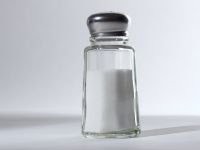Good guy or bad guy?
Humans and other animals need salt to survive. The lack of it triggers a behavioral response that motivates them to go after salty foods and liquids. Compared with the access difficulties of the past, modern societies ingest food with amounts much higher than their physiological needs, a custom considered harmful to health because it causes hypertension and cardiovascular disease.

by Varella Varella
The relationship between the use of salt and increased blood pressure is surrounded by so much controversy, it is difficult to establish safe limits for consumption.
Doubt
There is no consensus among experts that the salt reduction can prevent heart disease.
In pre-industrial communities, levels of blood pressure are lower. When these people adopt the diets of industrialized societies, there is an increased prevalence of hypertension. Joint analysis of several epidemiological studies (meta-analyzes) demonstrated that hypertensive adults maintaining a salt restriction exhibit steeper drops in blood pressure than a normotensive subject with the same type of intervention.
To give an idea of the modest impact of salt in the diet of children, a meta-analysis that brought together ten studies involving 966 participants 8-16 years of age, reducing by 42% the amount of salt intake, showed that there was a decrease of 0.11 cm the in the maximum blood pressure and 0.12 cm in the minimum.
Blood pressure response to salt is heterogeneous, however. and 30% to 50% of hypertensive and normotensive have a smaller percentage of salt sensitivity. Older people, obese, blacks and patients with metabolic syndrome (overweight, high blood pressure, blood glucose, cholesterol and triglycerides) are the most sensitive.
Several experimental models of hypertension demonstrated that the sensitivity is a genetically inherited trait confirmed in humans. Upon receiving a vein infusion of saline, black people with normal pressure excrete the injected sodium more slowly. The same phenomenon occurs among whites with a family history of hypertension.
Now see the contradictions
In 2009, Strazullo assessed 19 studies involving 177,000 participants. The salt intake was associated with a higher risk of stroke and other cardiovascular diseases. Some studies with fewer participants have not confirmed the existence of this association. Still others came to opposite results: a higher prevalence of cardiovascular disease was linked to diets with low salt content.
In 2011, O'Donnell published a survey in which both diets very high and very low in sodium are associated with higher risks of cardiovascular events.
A Cochrane meta-analysis carried out in the same year, involving 6,250 participants, found that reducing the amount of salt intake was not a strategy to reduce cardiovascular complications or mortality.
Paradoxical results such as these have been attributed to methodological differences and the small number of participants followed in several studies. Despite these contradictions, many countries adopted restrictive measures.
The first was Finland in the early 1970s. In 13 years, the reduction in consumption was accompanied by an average decrease of more than 1.0 cm in blood pressure in Finland and 75% to 80% of deaths from strokes and heart attacks.
In 2004, in England, an agreement between the health authorities and the food industry led to advertising campaigns that have made the British reduce consumption of 9.5 to 8.6 grams per day, in just four years.
Since 2005, the Department of Health of the United States has recommended that adult Americans meet the limit of 5.8 grams of salt per day.
In Brazil, the Ministry of Health recommends 10 grams daily consumed by the average Brazilian is reduced by half (five packets).
Source: CartaCapital
Translated from the Portuguese version by:
Lisa Karpova
Pravda.Ru
Subscribe to Pravda.Ru Telegram channel, Facebook, RSS!

